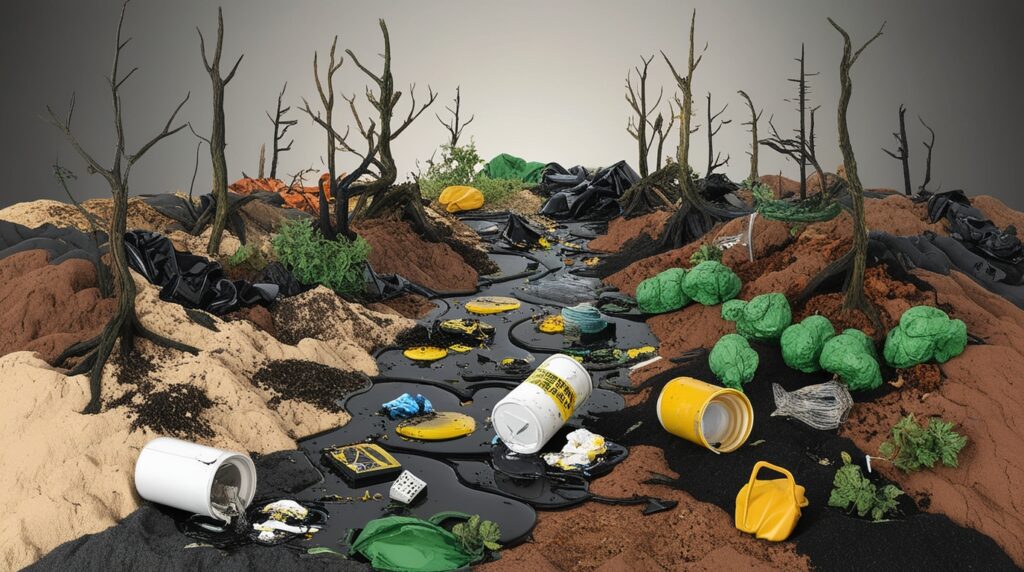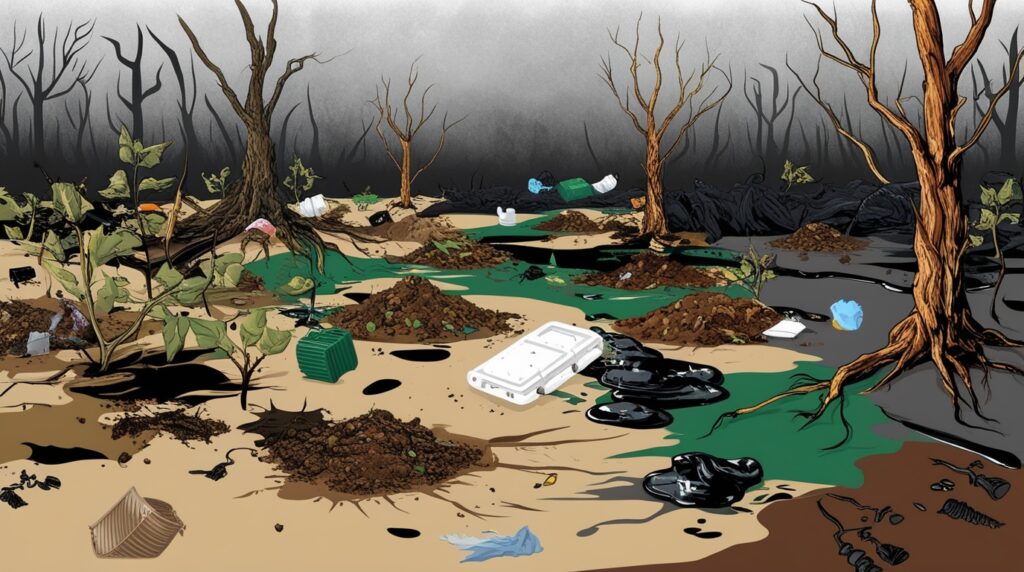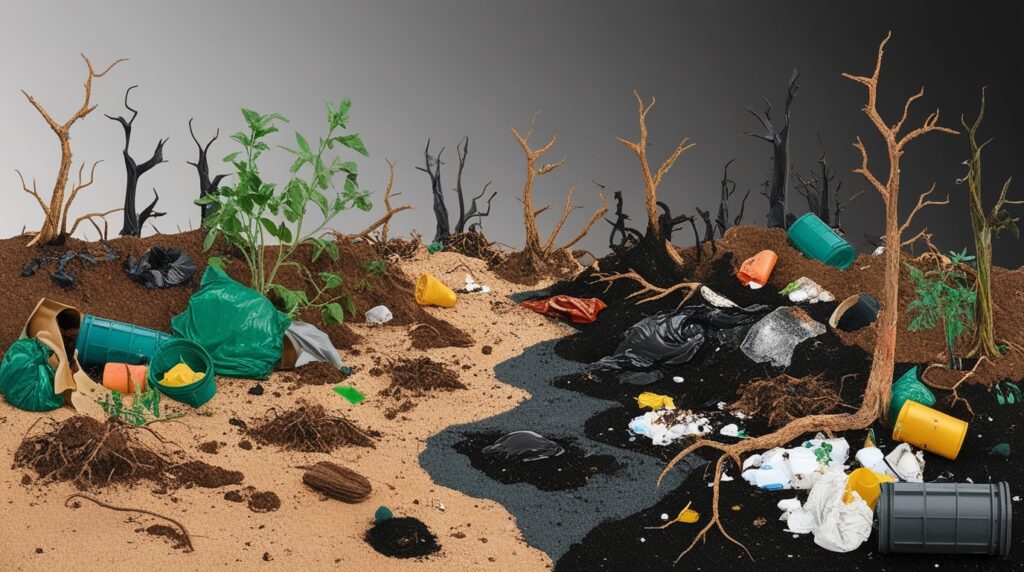
Soil is a vital natural resource that supports life on Earth by providing the foundation for agriculture, forests, and biodiversity. However, soil pollution has become a critical issue, threatening food security, ecosystems, and public health. This article explores the causes of soil pollution, its devastating impacts, and actionable solutions to address this global concern.
What is Soil Pollution?
Soil pollution occurs when harmful substances such as chemicals, heavy metals, plastics, and waste infiltrate the soil, altering its natural composition and rendering it toxic. Polluted soil not only affects plant growth but also poses risks to animals, humans, and the environment.
Major Causes of Soil Pollution
- Industrial Activities
Industrial waste, including heavy metals like lead, mercury, and cadmium, often seeps into the soil. Improper disposal of industrial by-products contributes significantly to soil contamination.
- Agricultural Practices
Overuse of chemical fertilizers, pesticides, and herbicides leads to the accumulation of harmful substances in the soil.
Intensive farming depletes soil nutrients, reducing its fertility over time.
- Improper Waste Disposal
Landfills and illegal dumping sites release toxins like plastic residues, batteries, and e-waste that leach into the soil.
Household waste, particularly non-biodegradable items, contributes to long-term soil degradation.
- Deforestation
The removal of trees and vegetation exposes soil to erosion and degradation. Deforestation also disrupts the natural nutrient cycle of the soil.
- Mining Activities
Mining for minerals and fossil fuels disturbs the soil structure and introduces toxic elements into the surrounding land, rendering it infertile.
- Urbanization and Construction
Urban expansion leads to soil compaction, loss of organic matter, and contamination from construction materials and waste.
- Oil Spills and Leakages
Oil spills during transportation or extraction release hydrocarbons into the soil, making it toxic and unsuitable for plant growth.
Impacts of Soil Pollution
- Threat to Agriculture
Soil pollution reduces fertility, affecting crop yields and threatening food security.
Contaminated soil can lead to the accumulation of harmful substances in crops, posing risks to human health.
- Water Pollution
Pollutants in the soil can seep into groundwater, contaminating drinking water sources and affecting aquatic ecosystems.
- Biodiversity Loss
Polluted soil harms microorganisms, insects, and plants that rely on healthy soil for survival.
Ecosystem imbalances occur as species migrate or die out due to habitat degradation.
- Public Health Risks
Soil contaminated with heavy metals and toxins can cause severe health issues, including cancer, neurological disorders, and developmental problems in children.
Inhalation or contact with polluted dust poses additional health hazards.
- Climate Change
Soil pollution disrupts the carbon cycle by reducing the soil’s ability to store carbon. Polluted soil can also emit greenhouse gases like methane and nitrous oxide, contributing to global warming.

Solutions to Combat Soil Pollution
- Promote Sustainable Agriculture
Reduce chemical pesticide and fertilizer use by adopting organic farming practices.
Practice crop rotation and use compost to improve soil health naturally.
- Proper Waste Management
Establish efficient waste segregation and recycling systems to prevent soil contamination from household and industrial waste.
Ban single-use plastics and encourage biodegradable materials to reduce plastic residues in the soil.
- Reforestation and Afforestation
Planting trees and vegetation helps stabilize soil, prevent erosion, and restore its natural nutrients.
- Enforce Regulations
Governments must implement strict policies to monitor and regulate industrial waste disposal, mining activities, and urban development to minimize soil pollution.
- Remediation Techniques
Use bioremediation methods, such as introducing plants and microorganisms that can absorb toxins, to restore polluted soil.
Apply soil washing or thermal desorption techniques for heavy metal contamination.
- Community Awareness and Action
Educate communities about the dangers of soil pollution and the importance of eco-friendly practices.
Encourage participation in local cleanup drives and soil conservation initiatives.
Global Initiatives to Address Soil Pollution
Organizations such as the United Nations Food and Agriculture Organization (FAO) and the Global Soil Partnership are working to combat soil degradation and promote sustainable land management. Efforts like World Soil Day emphasize the importance of healthy soil for sustainable development.
Conclusion

Soil pollution is a silent but deadly environmental issue that requires urgent attention. By understanding its causes and impacts, we can take meaningful steps to protect this vital resource. Sustainable practices, community involvement, and strong policies are essential for restoring and preserving healthy soil for future generations.
Photo Prompt for a Soil Pollution Awareness Campaign
“An impactful image showing a barren field strewn with garbage, including plastics, old tires, and industrial waste, with a factory emitting smoke in the background. In contrast, the foreground features environmental activists planting trees and cleaning up the soil. The scene captures both the devastating effects of soil pollution and the hope that collective efforts can restore our planet.”
Let me know if you’d like me to create a visual based on this description!





